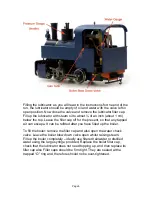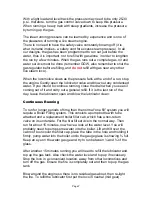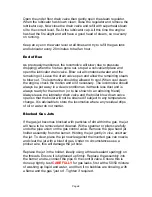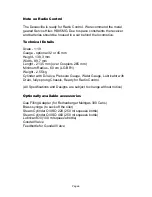
Page 3
When filling the lubricator, always use a high temperate steam oil; this is
available from us or other retailers. Failure to use the correct grade of oil
can lead to blocked steam pipes, and will invalidate the guarantee.
When running your engine avoid excessive speed and acceleration, both
will cause premature wear in the valve gear. Prototypically, narrow
gauge locomotives ran at speed of between 10 and 20 M.P.H. and never
exceeded 25 M.P.H.
Positions of Fillers and Drains etc.
The cab roof lifts up and tilts to the right hand side to give access to all
fillers.
The gas inlet valve is in front near side corner of the cab, at the top of the
gas tank turret. The gas control valve is attached to this turret, and can
be operated through the nearside cab doorway or open backside.
The lubricator is in the offside front of the cab, just forward of the
doorway and reverse lever. The filler cap has a “T” bar in it to aid
removal. The lubricator drain is directly beneath the lubricator. To drain,
open the ball valve downwards.
The boiler water filler is on top of the steam turret on the boiler in the
middle of the cab. Undo the knurled cap to fill with water.
The main steam regulator valve is located on the rear of the boiler-filling
turret and can be controlled through to open backside of the cab.
The water gauge is on the backside of the boiler in the middle of the cab
near the burner.
The boiler blow down valve is under the footplate, just in front of the
nearside cab. To open it, turn the ball valve downwards.
The direction control is the lever in the offside cab door. To operate pull
gently outwards and move to the desired direction. The control is “gated”,
and will therefore hold itself in the full forward or reverse position.




























